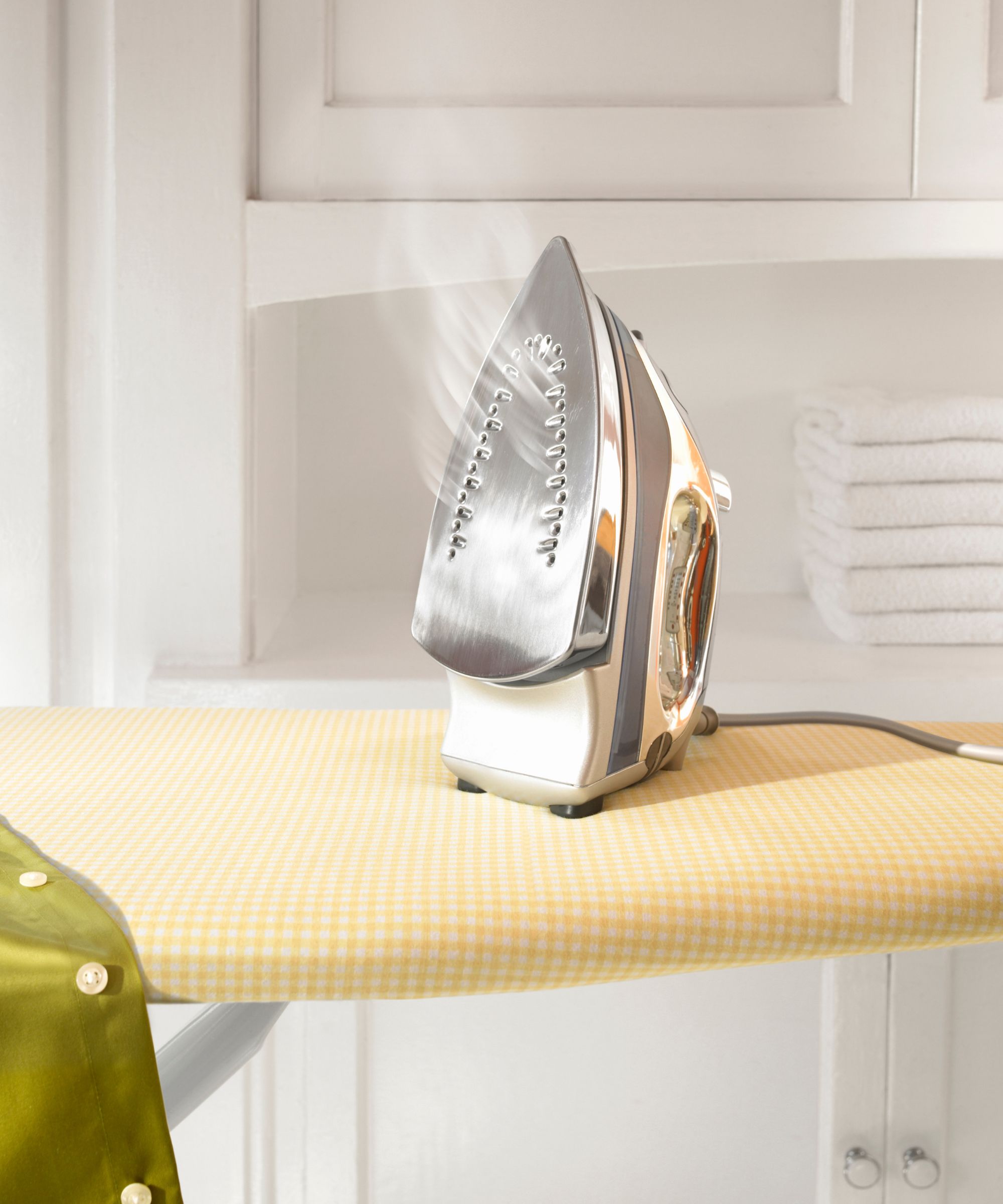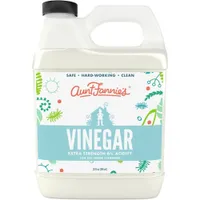How to clean the bottom of an iron with vinegar – 4 steps to clean this unsuspecting spot
This cleaning method requires no scrubbing but removes all corrosion and debris in one go


Given that we use our irons on clean clothing and only fill it with plain water many of us do not think to give them a clean. But when left untouched, these appliances quickly succumb to limescale build-up and corrosion.
The good news is that irons are one of the many things you can clean with vinegar – and you don’t even have to scrub to get them as good as new.
Here, cleaning experts explain how you can clean the bottom of your iron with vinegar and tackle the tricky steam ducts at the same time.
How to clean the bottom of an iron with vinegar
Although you can unwrinkle clothes without an iron, sometimes ironing is the easiest and most efficient option. Keeping the bottom of your iron clean and free from blockages is, therefore, essential to keeping your clothes clean and in good condition too.

1. Unplug the iron and let it cool
As with any cleaning tips for appliances, it is strongly advised to allow irons to cool down completely and remain unplugged before you begin cleaning. This not only allows the cleaner to work effectively before it is baked onto the base plate but also prevents you from accidentally getting burned.
You should have had the iron turned off for at least 45 minutes after you have used it, and it should be cool to the touch, recommends Mark Congionti, cleaning expert and CEO of iShine Maid Cleaning Services, NY.
2. Mix water and white vinegar to form a cleaning solution
Vinegar is a highly acidic cleaner that can cause damage to the metal if left undiluted, warns Karina Toner, cleaning expert from Spekless Cleaning. ‘To make a cleaning solution, mix equal parts white vinegar with distilled water,’ she recommends. ‘This concoction has the right amount of acidity to effectively and efficiently get the job done.’
Design expertise in your inbox – from inspiring decorating ideas and beautiful celebrity homes to practical gardening advice and shopping round-ups.
If your iron is heavily soiled or has burn marks, then the addition of baking soda to the mix can make for a slightly stronger cleaning solution without damaging your iron, adds Mark Congionti, cleaning expert.
‘Baking soda is slightly abrasive, so it has the ability to remove heavier residue,’ he explains. ‘Be aware that the combination of the ingredients will cause the solution to bubble and may overflow if your bowl isn't large enough when mixing.’
6% Distilled White Cleaning Vinegar | $11.99 at Amazon
This specially formulated white vinegar with cleaning strength at 6% acidity kills mold and breaks down grease, mineral deposits, lime scale, and built-up film for a clean space with no residue left behind and no rinsing required.

Karina is the Operations Manager at Spekless Cleaning, a trusted maid service based in Washington D.C. The team has over five years of experience providing top-quality cleaning services for both residential and commercial clients. Karina oversees every aspect of the business, ensuring that every client gets the same top-notch service every time.
3. Apply the cleaner with a microfiber cloth
To avoid scratching the base of your iron, use a soft microfiber cloth to apply the solution, paying close attention to any areas that have a noticeable build-up of limescale or rust, advises Mark Congionti, cleaning expert. It is important to never use anything metal or any strong abrasives for this task, he adds, as you can scratch the soleplate and promote the development of rust.
Alternatively, you can soak the cloth in the cleaning solution and wrap it around the iron base, allowing it to soak for half an hour before removing the cloth and wiping the base plate dry – removing all debris without having to scrub.
‘When using the baking soda paste, try not to get any of the paste into the steam holes to prevent it drying and clogging them up after cleaning,’ Mark continues. ‘If you do accidentally force some cleaner into the divots, simply wipe clean with a water-damp microfiber cloth. Then, clean out the steam holes with a Q-tip.
‘You may also find it useful to add some water to the reservoir and heat the iron, using the steam to force any cleaning paste out of the iron. Just make sure to let the iron cool again before continuing to clean.’
4. Fill the water chamber with the cleaning solution and turn on the steam
Given that it is tricky to clean the steam holes on the base of an iron without clogging them, it is a good idea to clean them from the inside, says Karina Toner.
‘You can use the same vinegar and water mixture in the water reservoir to unclog the vents, keeping in mind that this may not be appropriate for all types of steam irons, and the manufacturer's instructions should always be consulted before attempting to do so,’ she adds.
Add the solution to the reservoir and turn on the iron, allowing it to heat up with the steam function turned on. If needed, activate the steam using the button on your appliance, allowing the appliance to steam a few times until it releases without any spluttering or spitting.
Afterward, unplug the iron and allow it to cool before emptying the reservoir and setting the iron to cool and dry.
How to prevent dirt and grime in your iron
Keeping the iron clean and preventing limescale and rust buildup is much easier than allowing it to develop and cause blockages over time, and keeping your iron clean is very straightforward.
- Always drain water from your iron after every use: While it may seem logical to leave any remaining water in the reservoir to make ironing quicker next time, this can lead to leaks and limescale blocking steam vents, comments Laurie Klein, test kitchen specialist at Hamilton Beach Brands, a leading manufacturer of home appliances. ‘Draining the iron helps to prevent tiny particles from ending up on your clothes or causing colored marks when steaming too,’ she adds.
- Never iron over metal embellishments: Although common on our clothing, metal embellishments such as zippers, pins, metal rivets, or snaps, can scratch the iron's soleplate when you iron straight over them, Laurie Klein warns. Scratches, no matter how superficial, can encourage the development of rust as the protective patina is worn away. This can then discolor or even snag clothing, causing irreparable damage.
- Clean the iron frequently to prevent blockages: How often you clean your iron will depend largely on your usage and whether you use any starch or other products, begins cleaning expert Mark Congionti, however ‘every one to two months is generally recommended,’ he explains.

Laurie Klein is a consumer test kitchen specialist with over 12 years of experience using, cleaning and writing about irons and other household appliances to aid in the development of new technologies.
FAQs
How do I get burn marks off the bottom of my iron?
If you have black burnt spots on the base plate of your iron, then you can use a mixture of three parts baking soda to one part water or white vinegar to loosen the stain. Apply the paste and leave it to sit for up to 30 minutes, being careful to not get the paste embedded in the steam holes, before wiping it off with a damp cloth and drying it with a clean towel.
Can you use The Pink Stuff to clean an iron?
The Pink Stuff is a great cleaner to help freshen up the base of your iron, removing burn marks, rust stains, and limescale build-ups. As the paste is a mild abrasive, you should use a soft cloth to avoid scratching the base of your iron.
Keeping your iron clean and in working condition is a great laundry hack to save time as you'll never have to rewash clothes marred by a dirty iron or risk damaging your clothing for good.
Did you know there are several ways to use an iron around the home besides clothing, too?

Chiana has been at Homes & Gardens for two years and is our resident 'queen' of non-toxic living. She spends most of her time producing content for the Solved section of the website, helping readers get the most out of their homes through clever decluttering, cleaning, and tidying tips. She was named one of Fixr's top home improvement journalists in 2024.
